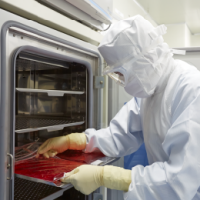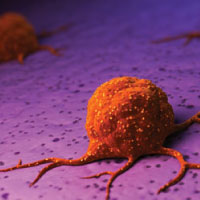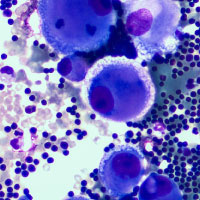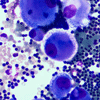CAR T-cell therapy: the latest weapon in the fight against cancer
 Cancer is one of our oldest and most bitter enemies, first described over 3,500 years ago in an Egyptian medical text (the Edwin Smith Papyrus). The course of action was surgical excision and cauterization. The outlook was dire: "There is no treatment."
Cancer is one of our oldest and most bitter enemies, first described over 3,500 years ago in an Egyptian medical text (the Edwin Smith Papyrus). The course of action was surgical excision and cauterization. The outlook was dire: "There is no treatment."
Though over three millennia removed, our first-line treatment options echo those of that Egyptian doctor: surgery, radiation, and chemotherapy. These strategies, while undoubtedly effective, target a tumor or cancerous cells but end up causing significant collateral damage, and their effectiveness varies with the type of cancer. Patients who have undergone these treatments, but still present with persistent or relapsed disease, are offered a poor prognosis.
In blood cancers such as leukemia and lymphoma, white blood cells divide uncontrollably and crowd out other blood cells from bone marrow and/or lymph nodes. A common first-line treatment is lymphodepleting chemotherapy, which uses cytotoxic drugs to target and kill rapidly dividing cancer cells. However, since this treatment targets all rapidly dividing cells, it kills not only cancer cells but also blood-forming hematopoietic stem cells (HSC), cells in hair follicles and the gastrointestinal tract, and others. This causes hair loss, nausea, cognitive/memory difficulties, sensory alterations (notably smell and taste), and heavy suppression of the immune system, putting patients at constant risk of contracting life-threatening infections. If this treatment is successful, the patient may receive an HSC transplant from a suitable donor in the hopes of achieving long-term remission. This treatment, though, can have complications such as graft versus host disease (GVHD), a potentially life-threatening condition where the transplanted immune cells perceive the host as foreign tissue and attack it.
But hope springs eternal. A new technology, termed chimeric antigen receptor (CAR) T-cell therapy, harnesses the power of a blood cancer patient's own T cells to attack their cancerous cells and brings with it the promise of remission without the risks of an HSC transplant or repeated chemotherapy. Here, we review the successes and challenges of CAR T-cell therapy and extend our tremendous gratitude and support to the researchers and clinicians who are making this treatment possible.
Weaponizing the patient's immune system
Unlike traditional cancer drugs and therapies, the strength of CAR T-cell therapy lies in a process that exploits a natural host defense mechanism carried out by T cells. In a typical immune reaction, an infected host cell presents foreign antigens on its surface using major histocompatibility complex (MHC) proteins. Using a specialized T-cell receptor, a T cell can bind to the MHC/antigen complex and determine whether it represents "self" (the host) or a foreign antigen. If the former, the T cell does not respond. However, if the T cell identifies a foreign antigen, it inflicts rapid cell death by delivering cytotoxic mediators directly to the infected cell.
How does this mechanism relate to cancer? In the case of B-cell cancers like acute lymphocytic leukemia (ALL) and diffuse large B-cell lymphoma (DBLCL), genetic and epigenetic changes transform a normal B cell into a cancer cell. When a single B-cell clone transforms, a unique portion of that clone's antigen receptor can be recognized by T cells, acting as a tumor-specific antigen. CD19 is a B-cell-specific signaling protein that makes for a good target for engineered T cells due to its overexpression on malignant B cells and lack of expression on hematopoietic stem cells, leaving those important blood-forming cells unharmed.
CAR T cells are designed to exploit this mechanism and specifically target malignant cells for destruction. Artificial T-cell receptors are made by combining 1) components derived from antibodies that specifically recognize certain cancer antigens, such as CD19, and 2) components with cytotoxic functions derived from T-cell receptors. CAR gene therapies involve transducing autologous lymphocytes with the TCR genes capable of recognizing cancer antigens; putting the lymphocytes back into the patient following lymphodepleting chemotherapy; and allowing these new lymphocytes to identify, attack, and eliminate cancer cells (Figure 1).
These cells have several advantages over traditional HSC transplants: in treating chronic lymphocytic leukemia (CLL), CAR T cells expanded ~4-log-fold, persisted long-term (>6 months), and—most importantly—were created with the patient's own cells, preventing the risk of GVHD (Kalos 2016). In this study, some patients achieved remission, but they had moderate side effects.

Figure 1. Workflow for T-cell-based therapies. CAR T-cell therapy involves removing a leukemia or lymphoma patient's T cells by leukapheresis (Step 1), modifying and expanding the T cells ex vivo so they express a chimeric antigen receptor that recognizes cancerous B cells (Steps 2 and 3), and then reinfusing the CAR T cells back into the same patient (Step 4). Several commercially available products (encompassing the aforementioned process) take the autologous approach (cells come from and are infused back into the same patient, avoiding GVHD), while several companies are developing therapies that use Steps 1–3 of the workflow but can be used to treat thousands of patients (allogeneic approach).
CAR T-cell therapies on the battlefield
At present, two CAR T-cell therapies are indicated for some patients with relapsed (comes back after remission) or refractory (resistant to chemotherapy) B-cell malignancies. In 2017, KTE-C19/axicabtagene ciloleucel (axi-cel) was the first CAR T-cell product granted FDA approval for the treatment of DLBCL. In May 2018, another CAR T product, tisagenlecleucel, was granted FDA approval for the treatment of not only relapsed/refractory DLBCL but also relapsed/refractory B-cell-precursor ALL. Incredibly, in a phase II clinical trial, 83% of 53 ALL patients treated with tisagenlecleucel experienced complete remission. Out of 81 DLBCL patients treated with tisagenlecleucel, 53% completely recovered and 74% of patients who achieved complete remission at three months were still cancer free at six months (Ogba et al. 2018).
While these results are promising, these CAR T-cell therapies still carry the risk of side effects. Cytokine release syndrome is the most commonly observed toxicity, with symptoms ranging from uncomfortable (fever, loss of appetite, pain) to life threatening (rapid heartbeat, seizures, low blood pressure, and breathing difficulties) (Brudno and Kochenderfer 2016). These treatments also carry the risk of neurological complications such as encephalopathy, seizures, and tremors, though these toxicities have been largely reversible.
The future of cancer warfare
Despite these setbacks, CAR T-cell therapies hold enormous promise moving forward. In addition to developing approaches to minimize adverse and off-target effects (reviewed in Bonifant et al. 2016), researchers are advancing CAR T-cell technology to improve target-cell cytotoxicity, cytokine production, and T-cell proliferation/survival (Figure 2). Additionally, while the current FDA-approved therapies target CD19, clinical testing is ongoing to target other B-cell antigens (CD20, CD22, CD23, and ROR1, among others) (D'Aloia et al. 2018).

Figure 2. Schematic of the evolution of CAR T-cell structures. Building on the original CAR T-cell technology, later generations have incorporated additional elements to aid in T-cell persistence, proliferation, cytokine production, and survival. Fourth-generation CAR T cells (termed "armored CARs") use modified second-generation CAR T cells engineered to express and secrete cytokines to improve efficacy. Image: Monica Casucci and Attilio Bondanza / Public Domain.
There is also a concerted push by researchers to expand this technology beyond blood cancers and allow CAR T-cell therapies to be applied to solid tumors. While several factors (including a lack of suitable antigen targets and poor delivery/persistence in solid tumors) have rendered these cancers more difficult to treat, there is reason for optimism. IL-13Rα-directed CAR T-cell treatment of an aggressive glioblastoma resulted in two of three patients exhibiting bioactivity consistent with anti-tumor responses (Brown et al. 2016). One patient in a separate study exhibited regression of multiple spinal and intracranial glioblastoma tumors for 7.5 months following treatment (Brown et al. 2015). In May 2018, a phase I clinical trial presented promising results demonstrating the safety profile of mesothelin-directed CAR T cells targeting mesothelioma (Adusumilli et al. 2018). Notably, one of the twelve patients experienced complete remission that, at the time of writing, had lasted 12 months and still exhibited detectable CAR T-cell activity.
Supporting our troops: a thank you to the scientists and medical professionals
Cancer is one of our oldest foes and, in one form or another, has touched the lives of nearly every one of us. Given their recent FDA approval and success, CAR T-cell therapies represent a promising line of inquiry in developing a next-generation approach to treating cancer. While current FDA-approved treatments are limited to B-cell malignancies, preclinical work and pilot trials have demonstrated the possibility of expanding these therapies into other types of cancers, including solid tumors.
An enormous amount of time, energy, and effort has been poured into bringing these technologies to this point, and we here at Takara Bio want to offer our sincerest thank you to the scientific and medical pioneers who strive to give a brighter future to cancer patients, cancer survivors, and their loved ones.
References
Adusumilli, P. S. et al. ASGCT 2018 presentation: A Phase I Clinical Trial of Malignant Pleural Disease Treated with Regionally Delivered Autologous Mesothelin-Targeted CAR T Cells: Safety and Efficacy - A Preliminary Report. <https://plan.core-apps.com/asgct2018/abstract/d959938d-eb06-44e2-8e21-1ba39a2fdcfe>
Bonifant, C. L., Jackson, H. J., Brentjens, R. J. & Curran, K. J. Toxicity and management in CAR T-cell therapy. Mol. Ther. – Oncolytics 3, 16011 (2016).
Brown, C. E. et al. Bioactivity and Safety of IL13R 2-Redirected Chimeric Antigen Receptor CD8+ T Cells in Patients with Recurrent Glioblastoma. Clin. Cancer Res. 21, 4062–4072 (2015).
Brown, C. E. et al. Regression of Glioblastoma after Chimeric Antigen Receptor T-Cell Therapy. N. Engl. J. Med. 375, 2561–2569 (2016).
Brudno, J. N. & Kochenderfer, J. N. Toxicities of chimeric antigen receptor T cells: recognition and management. Blood 127, 3321–30 (2016).
D'Aloia, M. M., Zizzari, I. G., Sacchetti, B., Pierelli, L. & Alimandi, M. CAR-T cells: the long and winding road to solid tumors. Cell Death Dis. 9, 282 (2018).
Kalos, M. Chimeric antigen receptor-engineered T cells in CLL: the next chapter unfolds. J. Immunother. Cancer 4, 5 (2016).
Ogba, N. et al. Chimeric Antigen Receptor T-Cell Therapy. J. Natl. Compr. Canc. Netw. 16, 1092–1106 (2018).

Clinical development of gene therapies targeting cancer
Takara Bio Inc. (TBI), the parent company in the Takara Bio Group of companies, is leading the way in the fight against cancer by developing technologies and conducting clinical trials for the treatment of acute lymphocytic leukemia, synovial sarcoma, malignant melanoma, and pancreatic cancer.
Explore TBI projects
Immunotherapy research
Immunotherapy uses the patient's immune system to control and destroy cancer cells and holds several key advantages over traditional therapies. Explore this section to learn about adoptive T-cell therapy, bispecific monoclonal antibody therapy, and T-cell receptor profiling, an important tool to guide treatment strategies.
Explore
Cancer research
Cancer research is constantly evolving and finding new and more effective therapies to battle disease. Explore this section to learn about biomarker discovery, single-cell analysis, genomics and epigenomics, HLA typing, immunotherapy, and gene editing for cancer therapy/drug discovery research.
ExploreTakara Bio USA, Inc.
United States/Canada: +1.800.662.2566 • Asia Pacific: +1.650.919.7300 • Europe: +33.(0)1.3904.6880 • Japan: +81.(0)77.565.6999
FOR RESEARCH USE ONLY. NOT FOR USE IN DIAGNOSTIC PROCEDURES. © 2025 Takara Bio Inc. All Rights Reserved. All trademarks are the property of Takara Bio Inc. or its affiliate(s) in the U.S. and/or other countries or their respective owners. Certain trademarks may not be registered in all jurisdictions. Additional product, intellectual property, and restricted use information is available at takarabio.com.




